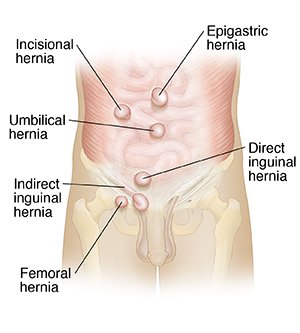A hernia is the protrusion of an organ through the structure or muscle that usually contains it. The condition occurs most often in the abdominal wall, when the intestine pushes through a weak spot in the wall. The most common abdominal wall hernia is an inguinal hernia.
A common symptom of most hernias is a noticeable lump or bulge, and potentially some discomfort or pain. The lump or bulge may not always be present; for example, it might go away when you lie down. Symptoms may worsen when you are standing, straining, or lifting heavy objects. Most hernias can be confirmed by a doctor during a physical exam, but sometimes imaging is necessary.

Open hernia repair is where an incision, or cut, is made in the groin. The hernia “sac” containing the bulging intestine is identified. The surgeon then pushes the hernia back into the abdomen and strengthens the abdominal wall with stitches or synthetic mesh. Most patients will be able to go home a few hours after surgery, and feel fine within a few days. Strenuous activity and exercise are restricted for four to six weeks after the surgery.
A laparoscopic (minimally invasive) hernia surgery uses a small incision into which the laparoscope is inserted. The instruments to repair the hernia are inserted through other small incisions in the lower abdomen. This procedure (Laparoscopic surgery) is usually performed under general anesthesia, so before the surgery, patient will have an evaluation of his/her general state of health. There is no or less pain during this surgery.
Robotic hernia repair, like laparoscopic surgery, uses a laparoscope and is performed in the same manner.Robotic surgery differs from laparoscopic surgery in that the surgeon is seated at a console in the operating room, and handles the surgical instruments from the console. While robotic surgery can be used for some smaller hernias, or weak areas, it can now also be used to reconstruct the abdominal wall.
One of the biggest differences between laparoscopic surgery and robotic surgery is that the use of the robot provides excellent three-dimensional images of the inside of the abdomen (vs. the two-dimensional images of laparoscopic surgery). Robotic surgery also allows the surgeon to easily use stitches to sew tissue and meshes inside the abdomen.